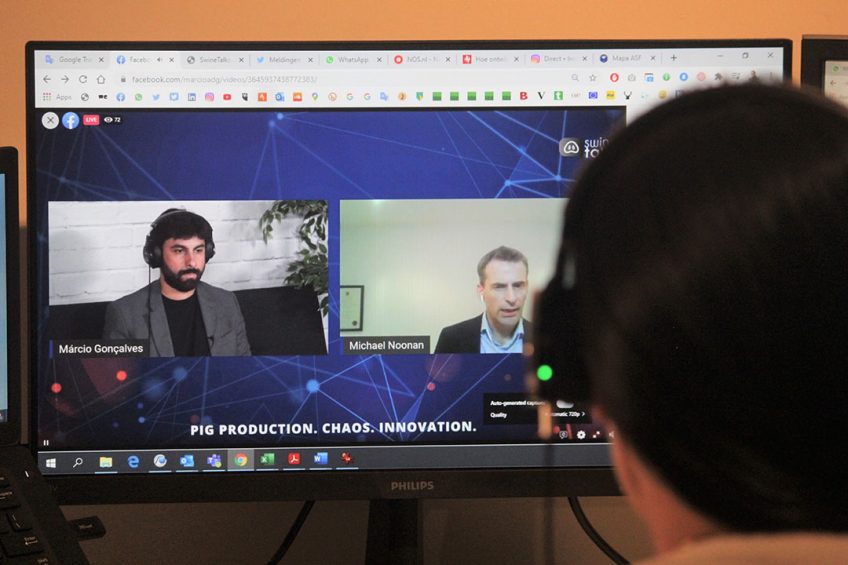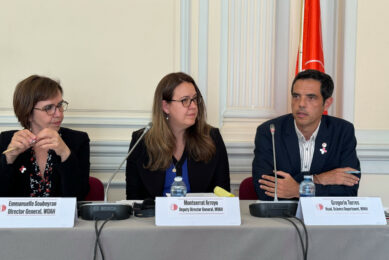SwineTalks: Online insights in biosecurity

In the world of international swine meetings, the virtual event SwineTalks is a new kid on the block. The first edition of this TED talk–like virtual event was held 7–8 October 2020, with 29 expert speakers presenting on a wide variety of swine subjects. The event attracted over 100 live participants. Pig Progress was one of them and homed in on those speakers addressing (respiratory) health issues and biosecurity. What messages did they share?

Biosecurity lessons learned in China
If there is one thing Chinese pig farmers have learned in the ongoing African Swine Fever (ASF) crisis, it is that good biosecurity is the top barrier that can guard against it. Dr Mu Li, nutritionist at Chai Tai Animal Husbandry Investment, China, outlined the steep learning curve that pig farmers undertook with biosecurity to safeguard their herds.
He also said there was some disregard for ASF from farmers in the southern parts of China when it first broke out on farms in the north in 2018, but how they, too, were soon affected when the disease spread rapidly within three months.
Dr Mu said: “We have learned a lot from ASF in China. The most important lesson is that all the producers realise the importance of biosecurity. If we don’t focus on biosecurity we will get punished. Biosecurity covers many details. There are three big differences after ASF. First is farm design. Before ASF producers mainly focused on pig flow, but now have new designs on new farms similar to American and EU farms. The second is adding washing centres to the farms, which are very expensive. They can cost US$ 40,000 each but now new farms have them. The third item is to build an animal health lab. Right now producers need fast analysis for ASF and have now built them on the farms. This allows them to take quick action if ASF is detected.”
Dr Mu added that he is confident the pork industry in China will be strong in the future.

Comparing Covid-19, ASF and Foot-and-Mouth Disease
Comparing ASF with Covid-19 and Foot-and-Mouth Disease to see what can be learned from them was the topic for Professor Luis Gustavo Corbellini, Federal University of Rio Grande do Sul, Brazil. “There are a lot of similarities between the three,” said Prof Corbellini. “All of them are caused by viruses and there are no vaccines for Covid-19 or ASF. Plus all of them are highly contagious and have serious consequences to people, producers, countries and continents.”
Prof Corbellini discussed vaccination and how some agricultural ministries have a different perception of vaccinations than that of primary producers. He also mentioned risk, in terms of disease, and what that meant in terms of tackling diseases. “Many countries are now planning mitigation strategies for ASF based on a risk assessment. This could help answer questions such as where will the most cases of ASF be or which population will be more vulnerable to it. “Communication strategies can also mitigate risk, but how many people plan them?” he asked.
He said early detection of a disease is one of the most important factors in how to control it. “In many cases producers are too afraid to report diseases because of the lack of trust and their reputation. So how do we solve that situation? One strategy is to engage the stakeholders into the system but this could fail and there needs to be a backup system to help,” he added.

Having an emergency plan
Jarrod Plants, from feed plant DFS Oskaloosa, in Iowa, USA, presented an interesting approach to how to prepare for a disease like ASF. In July 2019 he talked to expert people from the feed industry, pork producers and academia, asking them how they would prepare for the unknown. They devised a scheme in which the ASF threat levels were defined, from “Guarded” (virus not reported in North America), to “Elevated” (virus reported in North America), “High” (virus reported within 200 miles) and “Critical”, the highest level (virus reported inside the feed mill). The next thing they did was produce a biosecurity matrix, listing all kinds of measures that would need to be taken in various different situations depending on the emergency level.

Biosecurity in feed production
Dr Zhikai Zeng, senior research scientist at New Hope in China, delivered an insight into the situation with Chinese feed industry biosecurity. He said Chinese farmers, prior to ASF, had relied on vaccinations to prevent diseases entering their farms but now they realise more needs to be done in terms of biosecurity, even in terms of feed production.
Dr Zeng said: “Feed mill security is one of the key parts of the farm security system. If just one pig is infected you may lose the whole farm. The feed industry has the ability to respond within 24 hours of any possible case. Trucks should be clean and sanitised before they enter a feed mill. “Having separate zones within a feed mill is also good practice and an efficient way to reduce cross contamination by the virus. Workers coming from home should shower twice and change their clothes before entering a manufacturing facility. Trucks bringing in raw materials and those that deliver final products should be separated at the gates of the mill and directed to their specific zones. Choosing the right disinfectant for each specific situation is also important to break down the virus,” he said.

Monitoring and managing diseases
Monitoring and managing diseases was the topic for Dr Daniel Linhares, Iowa State University, USA, who delivered a comprehensive presentation. He said it was a “no-brainer” that viruses such as ASF cause an impact on productivity and on economic swine production. “The real question is how the virus would impact individual farm production and how much it would cost with or without intervention compared to the baseline of no infection,” he said. “The answer is not going to be found in books or research. The impact of disease really depends on the interaction between the pathogen cells, in this case virus, and immunity of that specific strain and other environmental factors which are unique to each production system. The answer to all of this is to have ongoing on-farm research to measure the impact of diseases and intervention on your own farm conditions,” he added.
Dr Linhares outlined a number of examples of research that looked at how disease can affect the different stages of pig production and how those farms with excellent productivity had good management practices in place together with high levels of employee training.

ASF and partial depopulation
Dr Clayton Johnson, Carthage Veterinary Service, USA, called ASF the “ultimate horror story for vets”. He said that in the absence of a vaccine, biosecurity is the only good strategy against ASF. He summed up elements that any biosecurity plan should have, including segregation – or building “firewalls” between farms or even within the farm.
Discussing what would need to be done if ASF made it to North America, he said, “We have seen the impact of undercover activists. Activists on the doorstep is the last thing we want. So we may not be able to do a euthanasia process in a rapid manner, as it is not acceptable from a public standpoint. So we may have to choose options other than mass depopulations.”
That is when he discussed “partial depopulation” – the idea being to avoid transmission. “So when building a barn, you should be thinking about compartmentalisation, which would include smaller barns, individual room exit doors, segregated entries per barn and fewer shared areas. He said, “That means that when a farm is built there should be the ability to have pigs and carcasses removed without having to go through a common area.”
He concluded by saying, “We should be proactive in considering alternative control strategies that effectively eliminate ASF. We should define thresholds at which partial depopulation would be an acceptable alternative to mass depopulation.

3 pillars of biosecurity
Reduction, separation and communication are the three main pillars of biosecurity, according to Professor Jean-Pierre Vaillancourt, University of Montréal, Canada. Basically, he argued, the principles have been around for centuries, and he presented examples of how past civilisations dealt with soldiers coming back from the battlefield or how they treated lepers. Reduction of the source of infection, then separation of the sick animals, away from the healthy ones – and then good explanation as to why it was done. Dr Vaillancourt gave good examples of where the reduction part went wrong, for example, by showing why footbaths can still lead to contamination if rules are not properly followed.
That is why the third pillar matters – good information and communication, he said. He showed a Google Maps picture of various farm sites close to each other. “An accountant would tell you there are 3 farms here. But when it is cold, when there is humidity, particles go from farm to farm. In fact it is one big site. What we need to do is minimise disease transmission. An app with virtual geofencing might help.”
Concluding, he said: “We have to do proper training and explain why. Adults will listen when they know why something is done. […] We need to look at innovative ways of reducing sources of contamination, separation and effective communication so we can have healthy pigs.”

Emerging diseases: Research remains important
“The reason you are all listening to me from your homes is related to an emerging disease: Covid-19,” said Dr Joaquim Segalés, from CReSA/IRTA, Spain. He gave a definition of an emerging disease – either it is a disease that appears for the first time, or it is a disease that already existed in nature, but has new incidents or occurs in a new geographical range. Most of these, he said, are caused by viruses. He summed up “recent” occasions of emerging pig diseases, like Porcine Reproductive and Respiratory Syndrome (PRRS), Porcine Circovirus type 2 (PCV2), H1N1 and Porcine Epidemic Diarrhoea virus (PEDv). He said, “But there is also a long list of potential agents we don’t know much about. Hepatitis, astrovirus, PCV3, PCV4; the list is almost endless. At the end of the day we have many potential candidates.”
Bacteria are interesting to follow, he said. “Most of those bacteria are well known. However, it became really interesting when PRRS came. It caused a modulation of the immune system.” In other words, known bacteria might suddenly cause a different reaction than they did before. He pointed out that emerging and re-emerging diseases are not only a matter of changes in viruses but that it is often also important to take the environment into consideration. On that basis he called for more enthusiastic research. “Everything depends on if you are looking for it or not. Every year 3 new infectious agents become known. Are they causing disease we have to worry about? Yes or no? We do not know.”
Supporting author: Vincent ter Beek











